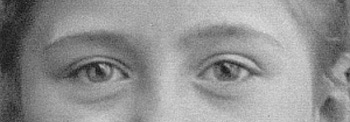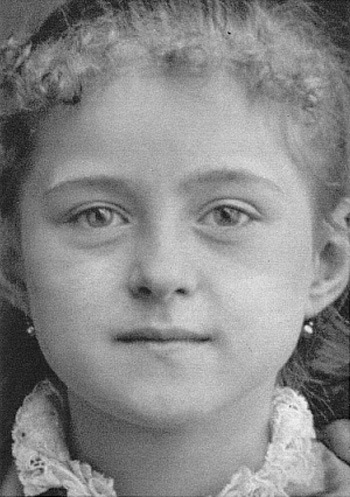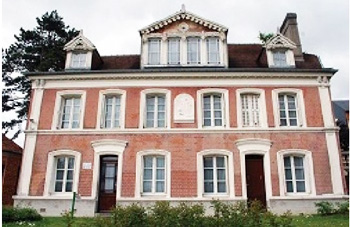Catholic Virtues
 |
 |
 |
 |
 |
 |
 |
The Personality of St. Therese of Lisieux - II
Her Gaze and Her Contemplative Soul
In the last article, we noted the first impressions generated by the photograph of St. Therese of the Child Jesus at age 8. We saw a great purity in this girl and a preservation of baptismal innocence. Let us continue with that analysis by looking more deeply at her gaze.
The eyes
 As we have noted, a kind of smile resides in that gaze. One sees that in the expression of
the physiognomy, the expression of the gaze, there is also something of what the French call espiègle – playful shrewdness. Concentrating the attention on the eyes, one realizes that there is in this gaze a whole firmament, a world of reflection that is starting to bud.
As we have noted, a kind of smile resides in that gaze. One sees that in the expression of
the physiognomy, the expression of the gaze, there is also something of what the French call espiègle – playful shrewdness. Concentrating the attention on the eyes, one realizes that there is in this gaze a whole firmament, a world of reflection that is starting to bud.
Contemplation
To whom is this gaze directed? It is not looking at any definite person or thing. It looks out at a vague, indefinite point, but with a kind of profound consideration, an elevated, amiable and respectful contemplation. In final analysis, it is a very contemplative spirit. It is still in its dawning, its springtime, it is true, but it is a strongly contemplative, meditative, interior gaze, already turned toward looking at the things of the spirit, at metaphysical things, at more or less infinite mental horizons.
It is a gaze that hovers in the infinite, in a sphere completely different from the normal thoughts of persons. In his Confessions, St. Augustine, reflecting on his childhood, said, "I was just a small child, but already a great sinner." About her it could be said: "She was just a little girl, but already such a great saint." Because her gaze has something that is difficult to express adequately, but a focus of soul on things that are entirely superior. Not indifferent, hostile or oblivious, but superior to the concrete, contingent, transitory and individual.
 She is not a person who is concerned about what you are thinking
of her. She does not care about the effect she is making on the photographer; she stands there the way she is. They told her that she should pose for a photograph, and so she did, obedient like the children of the Gospel whom Our Lord caressed and for whom the Kingdom of Heaven is reserved (Mt 18:3).
She is not a person who is concerned about what you are thinking
of her. She does not care about the effect she is making on the photographer; she stands there the way she is. They told her that she should pose for a photograph, and so she did, obedient like the children of the Gospel whom Our Lord caressed and for whom the Kingdom of Heaven is reserved (Mt 18:3).
She is not a philosopher-child, not at all. Such would be a caricature. She looks at the camera, but it is like a part of the ground floor of her soul. On top of this ground floor, which functions perfectly, there is a whole other construction. At that young age she could say to us what Our Lord said through the mouth of the Prophet Isaiah, one of the saddest phrases, one of His most beautiful complaints that most magnificently revealed His divine superiority: “For My thoughts are not your thoughts, neither are your ways my ways "(Is 55:8).
This linking of the ideas of thoughts and ways is magnificent: the thoughts of a person that directs his way, and acts as a harbinger of all the harmonies along the way. And how elevated were His thoughts! Think a little about the Holy Shroud. What thoughts! What a way! Couldn't that face on the Holy Shroud speak to us the same words of Isaiah? It could, and perfectly.
Given that Christianus alter Christus est (a Christian is another Christ), in this photo St. Therese could also tell us, "My thoughts are not your thoughts, neither are your ways my ways." She could well say this. Why? Because hers is a state of soul that is supremely meditative and uncommonly sacral. Hers is not the meditation of a philosopher or a theologian, but of a saint.
Meditative childhood
In the book History of a Soul this is confirmed in numerous places. She had, for example, the habit of climbing up to the top of her house to look out at the stars at night, among other things. That book speaks of the infinitudes in her thinking, in the vast expanses of her soul.
One has the impression that St. Therese had in her spirit all the counter-revolutionary doctrine, but she did not have the mission to make it explicit. She had the mission of dying for the counter-revolutionaries, of living and outlining the Little Way, which makes the Counter-Revolution accessible to the bulk of those who follow it. But there was a whole firmament of ideas in her spirit, which had already been delineated from that young age.
 She was an extremely meditative child. At the end of her life, when she was ripe for heaven and, therefore, when she had attained the holiness to which the plan of Providence had destined her, she spoke about the conversations she had with her sister. When she was about 10 – that is, a little older than she is in the photo here – she would go to a gazebo there in the
Buissonnets, and they would have conversations where she received more graces than those received by St. Augustine and St. Monica in the famous colloquies at Ostia's inn just before St. Monica died. This was when the sanctity of St. Monica had reached its peak and she was ready to go to Heaven.
She was an extremely meditative child. At the end of her life, when she was ripe for heaven and, therefore, when she had attained the holiness to which the plan of Providence had destined her, she spoke about the conversations she had with her sister. When she was about 10 – that is, a little older than she is in the photo here – she would go to a gazebo there in the
Buissonnets, and they would have conversations where she received more graces than those received by St. Augustine and St. Monica in the famous colloquies at Ostia's inn just before St. Monica died. This was when the sanctity of St. Monica had reached its peak and she was ready to go to Heaven.
One notices this in the backdrop of her gaze. It is a gaze that words cannot describe. If St. Peter were asked what the Lord's gaze told him, what could he say? He would answer: "It said something that caused me to weep the rest of my life. I wept the bitterest and sweetest tears that were ever wept, second only to those of Our Lady." And he would have nothing else to say because the gaze is something ineffable.
One either sees and feels this gaze or not, there is nothing to be done if you don’t. In one glance something that is supremely excellent is revealed: to see, to look with drooping eyelids. This is the gaze of the Holy Shroud. There Our Lord is with drooping eyelids, but He still looks out at us. And what a look! We do not cry only because we are not St. Peter.
Continued

The eyes

St. Therese's eyes
Contemplation
To whom is this gaze directed? It is not looking at any definite person or thing. It looks out at a vague, indefinite point, but with a kind of profound consideration, an elevated, amiable and respectful contemplation. In final analysis, it is a very contemplative spirit. It is still in its dawning, its springtime, it is true, but it is a strongly contemplative, meditative, interior gaze, already turned toward looking at the things of the spirit, at metaphysical things, at more or less infinite mental horizons.
It is a gaze that hovers in the infinite, in a sphere completely different from the normal thoughts of persons. In his Confessions, St. Augustine, reflecting on his childhood, said, "I was just a small child, but already a great sinner." About her it could be said: "She was just a little girl, but already such a great saint." Because her gaze has something that is difficult to express adequately, but a focus of soul on things that are entirely superior. Not indifferent, hostile or oblivious, but superior to the concrete, contingent, transitory and individual.

A soul of a saint already in her early age
She is not a philosopher-child, not at all. Such would be a caricature. She looks at the camera, but it is like a part of the ground floor of her soul. On top of this ground floor, which functions perfectly, there is a whole other construction. At that young age she could say to us what Our Lord said through the mouth of the Prophet Isaiah, one of the saddest phrases, one of His most beautiful complaints that most magnificently revealed His divine superiority: “For My thoughts are not your thoughts, neither are your ways my ways "(Is 55:8).
This linking of the ideas of thoughts and ways is magnificent: the thoughts of a person that directs his way, and acts as a harbinger of all the harmonies along the way. And how elevated were His thoughts! Think a little about the Holy Shroud. What thoughts! What a way! Couldn't that face on the Holy Shroud speak to us the same words of Isaiah? It could, and perfectly.
Given that Christianus alter Christus est (a Christian is another Christ), in this photo St. Therese could also tell us, "My thoughts are not your thoughts, neither are your ways my ways." She could well say this. Why? Because hers is a state of soul that is supremely meditative and uncommonly sacral. Hers is not the meditation of a philosopher or a theologian, but of a saint.
Meditative childhood
In the book History of a Soul this is confirmed in numerous places. She had, for example, the habit of climbing up to the top of her house to look out at the stars at night, among other things. That book speaks of the infinitudes in her thinking, in the vast expanses of her soul.
One has the impression that St. Therese had in her spirit all the counter-revolutionary doctrine, but she did not have the mission to make it explicit. She had the mission of dying for the counter-revolutionaries, of living and outlining the Little Way, which makes the Counter-Revolution accessible to the bulk of those who follow it. But there was a whole firmament of ideas in her spirit, which had already been delineated from that young age.

The Buissonnets, house where St. Therese passed her childhood
One notices this in the backdrop of her gaze. It is a gaze that words cannot describe. If St. Peter were asked what the Lord's gaze told him, what could he say? He would answer: "It said something that caused me to weep the rest of my life. I wept the bitterest and sweetest tears that were ever wept, second only to those of Our Lady." And he would have nothing else to say because the gaze is something ineffable.
One either sees and feels this gaze or not, there is nothing to be done if you don’t. In one glance something that is supremely excellent is revealed: to see, to look with drooping eyelids. This is the gaze of the Holy Shroud. There Our Lord is with drooping eyelids, but He still looks out at us. And what a look! We do not cry only because we are not St. Peter.
Continued

Posted May 20, 2019














